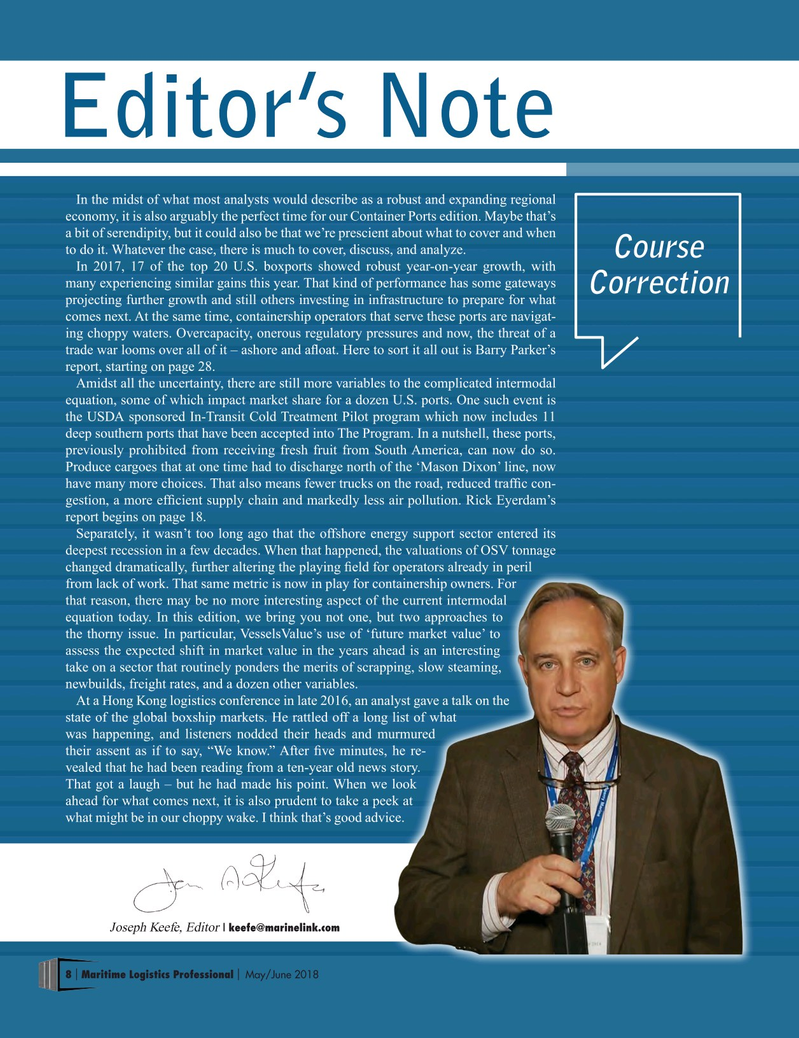
Page 8: of Maritime Logistics Professional Magazine (May/Jun 2018)
Container Ports
Read this page in Pdf, Flash or Html5 edition of May/Jun 2018 Maritime Logistics Professional Magazine
Editor’s Note
In the midst of what most analysts would describe as a robust and expanding regional economy, it is also arguably the perfect time for our Container Ports edition. Maybe that’s a bit of serendipity, but it could also be that we’re prescient about what to cover and when to do it. Whatever the case, there is much to cover, discuss, and analyze.
Course
In 2017, 17 of the top 20 U.S. boxports showed robust year-on-year growth, with many experiencing similar gains this year. That kind of performance has some gateways
Correction projecting further growth and still others investing in infrastructure to prepare for what comes next. At the same time, containership operators that serve these ports are navigat- ing choppy waters. Overcapacity, onerous regulatory pressures and now, the threat of a trade war looms over all of it – ashore and afoat. Here to sort it all out is Barry Parker’s report, starting on page 28.
Amidst all the uncertainty, there are still more variables to the complicated intermodal equation, some of which impact market share for a dozen U.S. ports. One such event is the USDA sponsored In-Transit Cold Treatment Pilot program which now includes 11 deep southern ports that have been accepted into The Program. In a nutshell, these ports, previously prohibited from receiving fresh fruit from South America, can now do so.
Produce cargoes that at one time had to discharge north of the ‘Mason Dixon’ line, now have many more choices. That also means fewer trucks on the road, reduced traffc con- gestion, a more effcient supply chain and markedly less air pollution. Rick Eyerdam’s report begins on page 18.
Separately, it wasn’t too long ago that the offshore energy support sector entered its deepest recession in a few decades. When that happened, the valuations of OSV tonnage changed dramatically, further altering the playing feld for operators already in peril from lack of work. That same metric is now in play for containership owners. For that reason, there may be no more interesting aspect of the current intermodal equation today. In this edition, we bring you not one, but two approaches to the thorny issue. In particular, VesselsValue’s use of ‘future market value’ to assess the expected shift in market value in the years ahead is an interesting take on a sector that routinely ponders the merits of scrapping, slow steaming, newbuilds, freight rates, and a dozen other variables.
At a Hong Kong logistics conference in late 2016, an analyst gave a talk on the state of the global boxship markets. He rattled off a long list of what was happening, and listeners nodded their heads and murmured their assent as if to say, “We know.” After fve minutes, he re- vealed that he had been reading from a ten-year old news story.
That got a laugh – but he had made his point. When we look ahead for what comes next, it is also prudent to take a peek at what might be in our choppy wake. I think that’s good advice.
Joseph Keefe, Editor | [email protected] 8 Maritime Logistics Professional May/June 2018 | |

 7
7

 9
9
